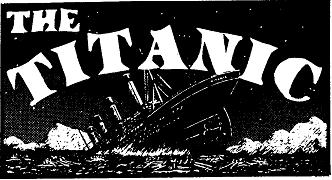
She was gigantic, awesome, the pride of the British White Star Line. Measuring 882.5 feet in length with a beam of 92.6 feet, she was the largest ship afloat. Weighing almost 50,000 tons, her two 38-ton wing propellers were accompanied by a centre steam turbine propeller, capable of propelling her through the water at 24 knots. Her four massive funnels weighed sixty tons each and were large enough for two railway locomotives to pass through, side by side. She held 6,000 tons of coal to feed her 29 coal fired boilers. Her 100 ton rudder was as high as a large house and her main anchor weighed 15 tons. Her interior was fitted with the best of materials and craftsmanship — nothing afloat could match her sheer elegance. Her name, TITANIC, coming from Titan, the sun god of ancient Greeks, also means, "One gigantic in size or power."
DEPARTURE
Wednesday, April 10, 1912 — 11.45
a.m.
With a blast from the largest and loudest deep throated sirens ever made, she slipped away, with majestic greatness, from Southampton, England, to begin her maiden voyage to New York. At the helm was a veteran of the sea, Captain E. J. Smith who had previously commanded seventeen ships for the White Star Line. If passengers ever had total confidence in a sea captain, it was in Smith. The ship's builders had announced this vessel to be unsinkable. She had a double bottom and sixteen water tight compartments. Smith said, "I can't imagine any condition that would cause a ship to founder ... modern shipbuilding has gone beyond that." Some of the crew assured passengers, saying, "God Almighty couldn't sink this ship!" In their minds the name Titanic suited her well! Little did her passengers and crew know that this was not only her maiden voyage — but her last! The Titanic was sailing, in all her splendour, for a rendezvous with death. Is there not a lesson in this for us? God says, "Boast not thyself of tomorrow; for thou knowest not what a day may bring forth" (Proverbs 27 v.1). If your rendezvous with death were to come tonight — what then?
DELIGHT
Four days out to sea and what a unique and pleasurable experience. No vibrations from the leviathian engines so common to sea-going ships. Unsurpassed comfort and entertainment on board, combined with speed unparalleled in those days. Pride filled the crew and passengers alike, as the Titan of the Seas plowed through the Atlantic's forbidding icy waters. Never had a ship carried so many millionaires in its first class quarters. Even J. B. Ismay, Chairman of the White Star Line was aboard. This was a voyage to be remembered — in more ways than one!
DEAFNESS
It was a crystal-clear, calm Sunday night as the Titanic sailed on at full speed ahead — but nature was against her in three ways. (1) A mild Winter had caused an enormous spawning of icebergs from Greenland's Northern Coast into the shipping lanes of the Atlantic. (2) No breeze, which would have created ripples around an iceberg's base, producing a phosphorescent glow visible for miles. (3) A moonless night, thus darkness. Philips, the chief wireless operator, had received five warnings that day of icebergs nearby from other ships. Unheeded, the Titanic never slackened her pace. Many people today are the same. Turning a deaf ear to the warnings of God they continue on in their sinful course without regard to their fate. "For God speaketh once, yea twice, yet man perceiveth it not" (Job 33 v.14). How about you?
DESPAIR AND DOOM
Sunday, April 14th, 1912 — 11.40
p.m.
Up in the crow's nest, seaman Fleet's eyes peered ahead in the cold, moonless, starry night. The Titanic, curling a white wave of foam at her bow plowed on at full speed! Suddenly Fleet saw it! Ringing the warning bell he screamed, "Iceberg, dead ahead!" Murdoch, the First Officer, yelled to the helmsman, "Hard-a-Starboard!" Then he sprang to the lever closing the watertight doors. But it was too late — an ominous shudder ran through the ship as a huge spur of ice under the waterline tore open a 300-foot gash in the starboard forepart of the ship. She had sailed 546 miles that day, to meet her fate. Two hours and forty minutes later, at 2.20 a.m., April 15th, raising her stern as a final tribute to the North Atlantic who was claiming her, the costly and "unsinkable" Titanic made her death plunge to her watery grave 2½ miles below. Her life was short, reminding us of ours. "They are passed away as the swift ships" (Job 9 v.26). What is your life? "It is even a vapour, that appeareth for a little time, and then vanisheth away" (James 4 v.14).
There were not enough lifeboats for all! Listen to the testimony of a survivor. "The agonizing cries of death from over a thousand throats. The wails and groans of the suffering, the shrieks of the terror stricken, and the awful gaspings for breath of those in the last throes of drowning, none of us will ever forget to our dying day." Six hours later the last survivor was taken on board the Carpathia. The count was made — 705 saved, over 1500 lost! Most perished that night. How similar to man's spiritual condition today, regarding God's salvation. The Lord says, "Few there be that find it" (Matthew 7 v.14). However, unlike the Titanic, God has a Lifeboat for all, and that Lifeboat is Christ! He shed His blood at Calvary. He died. Then He rose again, and is willing to save you in virtue of His finished work. "For the Son of man is come to seek and to save that which was lost" (Luke 19 v.10). Are you lost? Then, "Believe on the Lord Jesus Christ, and thou shalt be saved." (Acts 16 v.31).